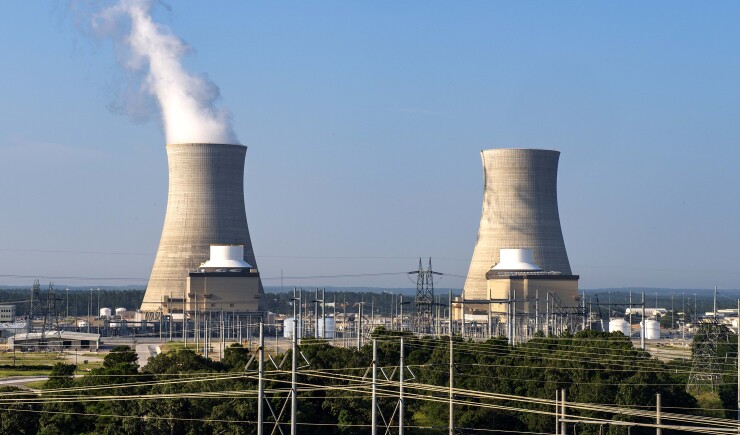Quickly rising demand for energy in Georgia has left a major state power provider searching for additional sources of electricity to meet growing near-term needs, all while keeping in mind carbon-zero commitments.
Just a little over a year after Georgia Power released its Integrated Resources Plan, a blueprint for meeting power demand through 2030 and beyond, the company has revised predictions for needed capacity after an unexpected rapid rise in energy use driven by the arrival of more energy-intensive industries in the state, officials said.
Assessments made in 2022 about future energy demand were now moot, Georgia Power said in an updated version of its IRP. Needed capacity through 2030 was reevaluated to be 17 times higher than previously laid out, even with the inclusion of new and ongoing projects like efforts to expand its nuclear energy output that have recently started producing power.
Georgia Power
“Georgia has continued to experience rapid economic growth since the filing of our IRP in early 2022,” Kim Greene, chairman, president, and CEO of Georgia Power, said in a statement. “Many businesses coming to the state are bringing large electrical demands at both a record scale and velocity. … this IRP Update outlines how Georgia Power can best continue supporting that historic growth while continuing to provide our customers with the clean, safe, reliable, and affordable energy they expect and deserve.”
Georgia Power said the update was unscheduled but necessary as demand has increased and accelerated while uncontracted generation resources in the wholesale market has decreased. This comes at the same time as constraints on the time required to build or buy energy from new resources grew.
To meet that updated demand through 2030, the company will draw on several new sources of energy, including new power purchase agreements with Mississippi Power for 750 MW of electricity from coal and natural gas plants, and Florida-based Santa Rosa Energy Center for 230 MW of additional capacity from a natural gas-fired plant. Combustion turbines will also be added at Georgia Power’s existing Plant Yates.
Additionally, the company plans to expand battery storage systems and solar capacity, while constructing new solar arrays, and investing in biomass-related power generation.
Officials said they are also seeking approval for the transmission infrastructure to connect the new power sources to the grid, ensuring “the continued reliability and resiliency of Georgia’s electric system.”
With negotiations and approvals still pending on the stop-gap measures, a dollar figure on increased costs is hard to tack down. According to the updated IRP, Georgia is proposing to recover costs associated with several of the sources of new power generation in its retail cost of service. Any additional rate hike would come on top of a 12% increase approved by state regulators that took effect in June.
Georgia Power then said the increase was necessary as energy demand and costs associated with ongoing work on new nuclear reactors at their Plant Vogtle rose.
Officials linked the rise in demand squarely to the state’s economic development efforts that have led to a growing number of power-hungry manufacturing industries calling Georgia home.
Georgia Power noted substantial increases across several industries since fiscal 2021, resulting in job creation in the automotive industry by 324% and the agricultural industry by 29%, with investments in the aerospace industry increasing by more than 1,000%.
Georgia Power officials said the size of several projects, including the state’s most recent electric vehicle incentive agreement with Rivian, launched over the last few years were larger in terms of investments and eventual energy needs.
In fiscal 2023 alone it noted new investmentsof $24 billion for 426 projects across all industries, creating 38,400 new jobs. Combined with a corresponding population boom, the state’s energy requirements skyrocketed.
Similar balancing acts, weighing costs with additional capacity and climate commitments, are unfolding across the U.S. Southeast where billions in economic incentives are supercharging localized industrial development, and in some states, it is taxing local power networks.
Investor-controlled Duke Energy, North Carolina’s largest energy provider, which also services South Carolina, found a similar need to update plans to meet an increased demand while lawmakers in South Carolina met on Oct. 18 to discuss the issue of increased power demand. State Speaker of the House Murrell Smith said the quick pace of economic development and population growth were bringing the state’s power grid to a “crisis point.”
In Tennessee, the Tennessee Valley Authority cleared new funds to grow a diversity of electrical generation capacity, citing growing demand that outstrips the sum total to be provided by major projects underway. The TVA reported that U.S. Southeast’s electrical demand was growing faster than the national average, resulting in a nearly 3% increase in power demand from 2019 to 2022.
Dominion Energy in Virginia recently projected massive growth in its local power demand over the next four years, A 214% increase in Northern Virginia alone.
Florida has reported also increased demand linked to population growth and economy, as has Alabama, and both have sought to grow and diversify localenergy production.
According to the Energy Information Administration’s Annual Energy Outlook report for 2023, consumption of all forms of energy in the United States is expected to increase from a range of 0% and 15% from 2022 to 2050, with the industrial sector expected to see the most growth.
Before implementation, Georgia Powers new plan must be approved by the state’s Public Service Commission.
